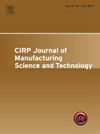Melt pool dynamics and microstructural growth prediction of additively manufactured thermoelectric material
IF 5.4
2区 工程技术
Q2 ENGINEERING, MANUFACTURING
CIRP Journal of Manufacturing Science and Technology
Pub Date : 2025-04-02
DOI:10.1016/j.cirpj.2025.03.004
引用次数: 0
Abstract
Laser powder bed fusion (L-PBF) method of additive manufacturing is typically applied to metallic alloys for structural applications. It may be applied to fabricate components of functional materials such as the binary Mg2Si alloys with appropriate parameter optimization for energy harvesting applications. The L-PBF processing of such a material requires critical control over the input laser power and scan speed to minimise the structural defects in the end product. We developed a Computational Fluid Dynamics (CFD) model in MATLAB to simulate the thermal profiles of the dynamic molten pool to modulate the applied laser power and the scan speed. The material’s melting point and the conventional sintering temperature were used as the baseline numbers to scrutinize the suitable laser parameters. The CFD modeled laser parameters were tested to fabricate L-PBF processed Mg2Si and the conventional sintering temperature of 1173 K was found to be a better limiting criterion than the melting point to prevent excessive balling and Mg vaporization. The fluidic flow velocity and its effect on the melt pool dynamics were observed experimentally. The microstructural variations in such materials are known to affect their thermoelectric performance, and the high cooling rate during the solidification in the L-PBF process favors dendritic growth, which differs from the conventionally fabricated samples possessing equiaxed grains. The microstructure evolution from the rapid solidification of the melt pool was predicted using the phase field analysis considering the effects of perturbation and the strength of anisotropy. A computational domain was simulated with an initial nucleation site of diameter 0.35 µm, and the directional dendritic growth patterns for different laser power and scan rates were obtained and analyzed. A comparable interdendritic spacing between the simulated primary dendritic arms (0.46 µm) and that measured within the L-PBF processed sample (0.57 µm) as seen under a Scanning Electron Microscope (SEM) is obtained, indicating the model’s efficacy in simulating the possible growth mechanism. The phase evolution of the L-PBF processed Mg2Si component with the implication on its thermoelectric performance and the challenges in its fabrication are discussed.
增材制造热电材料熔池动力学及显微组织生长预测
激光粉末床熔融(L-PBF)增材制造方法通常应用于金属合金的结构应用。它可以应用于制造功能材料的部件,如二元Mg2Si合金,并对其进行适当的参数优化,以用于能量收集应用。这种材料的L-PBF加工需要对输入激光功率和扫描速度进行严格控制,以尽量减少最终产品中的结构缺陷。在MATLAB中建立了计算流体动力学(CFD)模型,模拟了动态熔池的热分布,以调节激光功率和扫描速度。以材料的熔点和常规烧结温度为基准,考察合适的激光参数。利用CFD模拟的激光参数对L-PBF加工Mg2Si进行了测试,发现常规烧结温度1173 K比熔点更适合于防止球化和Mg汽化。实验观察了流体流动速度及其对熔池动力学的影响。这种材料的微观结构变化会影响其热电性能,并且在L-PBF过程中凝固过程中的高冷却速率有利于枝晶生长,这与传统制造的具有等轴晶的样品不同。考虑微扰和各向异性强度的影响,采用相场分析方法预测了熔池快速凝固过程中的微观组织演变。模拟了直径为0.35µm的初始形核区域,得到了不同激光功率和扫描速率下枝晶的定向生长规律。模拟的初生枝晶臂间距(0.46µm)与扫描电子显微镜(SEM)下L-PBF处理样品内测量的枝晶臂间距(0.57µm)相当,表明该模型在模拟可能的生长机制方面是有效的。讨论了L-PBF处理的Mg2Si元件的相演变及其对热电性能的影响,并讨论了其制造中的挑战。
本文章由计算机程序翻译,如有差异,请以英文原文为准。
求助全文
约1分钟内获得全文
求助全文
来源期刊

CIRP Journal of Manufacturing Science and Technology
Engineering-Industrial and Manufacturing Engineering
CiteScore
9.10
自引率
6.20%
发文量
166
审稿时长
63 days
期刊介绍:
The CIRP Journal of Manufacturing Science and Technology (CIRP-JMST) publishes fundamental papers on manufacturing processes, production equipment and automation, product design, manufacturing systems and production organisations up to the level of the production networks, including all the related technical, human and economic factors. Preference is given to contributions describing research results whose feasibility has been demonstrated either in a laboratory or in the industrial praxis. Case studies and review papers on specific issues in manufacturing science and technology are equally encouraged.
 求助内容:
求助内容: 应助结果提醒方式:
应助结果提醒方式:


